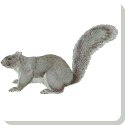 Squirrel — A squirrel is any member of the rodent family Sciuridae–with the exception of the marmots, Marmota; prairie dogs, Cynomys; and chipmunks, Eutamias and Tamias–and typically has a slender body and a long, bushy tail. The name is more commonly used to refer to those forms which live in trees, although it is equally suited to terrestrial types. It is also used for arboreal African rodents of the family Anomaluridae, which are known as scaly-tailed squirrels.
Squirrel — A squirrel is any member of the rodent family Sciuridae–with the exception of the marmots, Marmota; prairie dogs, Cynomys; and chipmunks, Eutamias and Tamias–and typically has a slender body and a long, bushy tail. The name is more commonly used to refer to those forms which live in trees, although it is equally suited to terrestrial types. It is also used for arboreal African rodents of the family Anomaluridae, which are known as scaly-tailed squirrels.
The family Sciuridae contains two subfamilies, the Sciurinae (the tree and ground squirrels), with about 225 species, and the Petauristinae (the FLYING SQUIRRELS), with about 35 species. Squirrels are distributed throughout the world except for the Australian region, Madagascar, southern South America, and certain desert regions, such as the northern Sahara and Arabia.
Squirrels vary in size from such tiny tropical forms as the pygmy squirrels, Myosciurus, of Africa, which are about 130 mm (5 in) in length including the tail, to the giant squirrels, Ratufa, of Asia, which may attain 91 cm (36 in). The tree and ground squirrels are typically diurnal, and the flying squirrels, nocturnal. Squirrels primarily eat green vegetation, seeds, nuts, berries, fruits, and insects.
The American eastern gray squirrel, Sciurus carolinensis, typical of the tree squirrels, is native to the forests of the eastern half of the United States. Introduced into the United Kingdom, it has displaced the smaller native red squirrel, S. vulgaris, in many regions. Gray squirrels have many color variations. Nesting is normally in tree hollows; gray squirrels also may construct leaf nests, which are used mainly as feeding shelters. Gray squirrels may breed in midwinter and again in late spring. Gestation is about 44 days, with usually two to four young per litter.
Ground squirrels are similar in appearance to tree squirrels. They typically inhabit open or brushy regions, with some species occurring in tundra or desert. Most are burrowers, and those living in colder climates hibernate, whereas others, in hot, dry areas, may estivate.
Unlike rabbits or deer, squirrels cannot digest cellulose and must rely on foods rich in protein, carbohydrates, and fat. Early spring is the hardest time of year for squirrels, since buried nuts begin to sprout and are no longer available for the squirrel to eat, as well as new food sources have not become available yet. During these times squirrels rely heavily on the buds of trees, in particular, those of the Silver Maple. squirrels are omnivores; they eat a wide variety of plant food, including nuts, seeds, conifer cones, fruits, fungi, and green vegetation, and they also eat insects, insect larvae, eggs, and even small birds, smaller mammals, frogs, and carrion. In tropical areas, these foods often replace nuts. Ground and tree squirrels are typically diurnal, while flying squirrels tend to be nocturnal — except for lactating flying squirrels and their offspring, who have a period of diurnality during the summer.
 Kids Portal For Parents India Kids Network
Kids Portal For Parents India Kids Network






